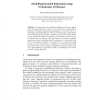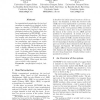1728 search results - page 56 / 346 » Self-Organisation: Paradigms and Applications |
PROCEDIA
2011
12 years 11 months ago
2011
Two decades of microprocessor architecture driven by quantitative 90/10 optimization has delivered an extraordinary 1000-fold improvement in microprocessor performance, enabled by...
CAEPIA
2003
Springer
14 years 2 months ago
2003
Springer
The development of software systems is a complex task that requires support techniques to guide the process and solve inconsistencies in its . In the agent paradigm, the use of soc...
PLILP
1998
Springer
14 years 29 days ago
1998
Springer
: The bene ts of the object, logic or relational, functional, and constraint paradigms can be obtained from our previous combination of the object and functional paradigms in hidde...
AISB
1997
Springer
14 years 28 days ago
1997
Springer
A technique for the credible modelling of economic agents with bounded rationality based on the evolutionary techniques is described. The genetic programming paradigm is most suite...
ANLP
1997
13 years 10 months ago
1997
In computational morphology the two-level paradigm is regarded as a standard in this paper we describe CATMORF, the rst wide-coverage multi two-level steps morphological analyzer ...


